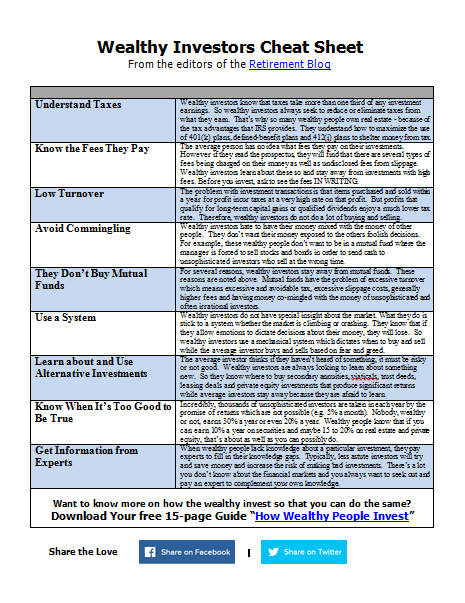
Even in this low rate environment, you can earn 6% on bank preferred stocks, including such names as as Bank of America, Wells Fargo and J.P. Morgan. Why hasn’t your financial advisor told you about this? Because he earns more by selling you a mutual fund with a higher upfront or continuing commission.
Additionally, it takes some research and detail checking to recommend to you appropriate preferred shares.
Bank Preferred Stocks Basics
Companies issue preferred shares as a way of raising money to build facilities, expand their business, buy another company or for other corporate cash needs. These preferred shares pay a fixed dividend similar to a bond.
One page "invest like the rich" cheat sheet provides short explanations of how the rich investment differently. You don't need to be rich to copy what they do. Download now.
However, should the cash flow of the company become impaired the bondholders get their interest first, then the preferred shareholders get their dividend and last, the common shareholders get their dividend. Many preferred shares are cumulative, such that if the dividend is missed, it gets paid later when the company has more adequate cash flow.
Most preferred shares are issued at $25. They pay dividends quarterly. They trade on the stock exchange just like common stock. They do not fluctuate as widely as common shares.
As an example, here is the chart of the JP Morgan preferred shares I discuss below. Over the last year, the shares have ranged from $25.76 to $27.97. That’s not much fluctuation compared the last 12 months for the average common stock.

Economics of Bank Preferred Stocks
Preferred shares do not mature. They continue to pay their dividends until the company calls in the shares, at their discretion, usually at $25. Therefore, you must do some calculations when you need to pay above $25 per share. If it has a call date coming up soon when you could be forced to take $25 per share, you have a loss on your principal. However, the high dividend rate often offsets this loss.
This should be elementary for your broker and he should be able to find you some very conservative preferred shares with high yields. However, he may rather sell you a fund as it is easier.
The reason this author likes bank preferred shares is their “too big to fail” protection. As we saw during the great recession 2007-2009, the federal government came to the rescue of these large banks. A failure of any one of these banks would create widespread financial problems. Therefore, these banks have a type of government protection that other industries do not.
All ten alternatives summarized on a one page "Retirement Income Cheat Sheet." From the editors of the Retirement Income Blog. Get your free copy now.
Examples of Bank Preferred Stocks
Here are some examples of preferred shares trading now (2/29/16):
Bank of America series W.
These shares pay 41.4 cents per share every 3 months. The shares closed today at $25.93. Therefore, the current yield is the annual dividend divided by the price = 6.4%. But, Bank of America has the option to call in these shares 9/9/19 for $25. Therefore, you would collect your 6.4% and if the bank decided to call your shares on 9/9/19 at $25, you would lose 93 cents per share on the principal. The money you collect as dividends is offset by the 93 cent loss so your overall yield could be as low as 5.46% if bank of America calls the shares at the earliest allowed date.
In the case of the bank calling in the shares at $25 and you paid above $25, we always calculate “yield to worst.” This is your worst case overall yield from the dividends and any loss (or gain) in your shares.
Wells Fargo Series V.
These shares pay 37.5 cents every 3 months. Shares today are $26.02 and the current yield is 5.76% On December 15, 2020, Wells may call the shares at 25. If they do, your “yield to worst” is 5.08%.
JP Morgan Series T.
These shares pay 41.875 cents per share every 3 months for a current yield of 6.16% on a current price of $27.17. JP Morgan can call these shares at $25 per share on 3/1/19 for a Yield to worst of 3.65%.
In all of the above cases, the shares are currently trading above “par” of $25 per share. Sometimes, you can buy the shares below par. In such case, you of course receive the dividends plus a profit per share when the shares are called at par.
You are free to sell your shares at any time on the stock exchange just like you do with common stock.
If your financial advisor is not familiar with preferred shares, you want to be sure that you get the type which qualify for “qualified dividend” treatment. You can find a list here (you will need to create a free account).

Leave a Reply